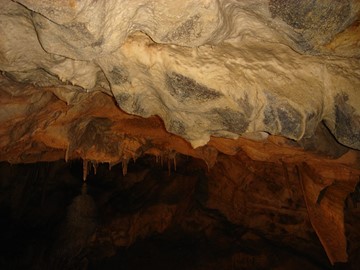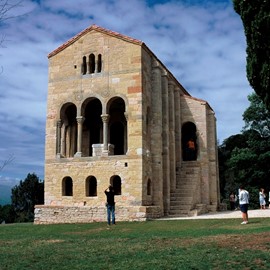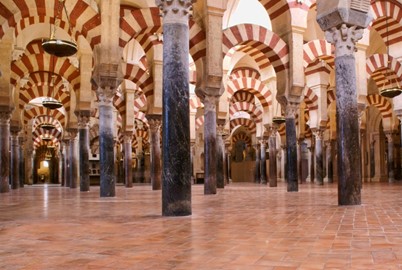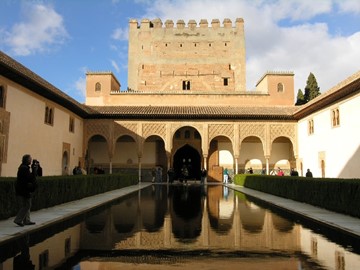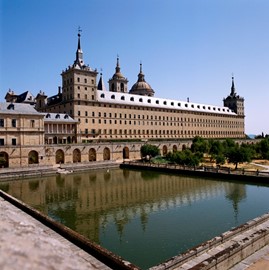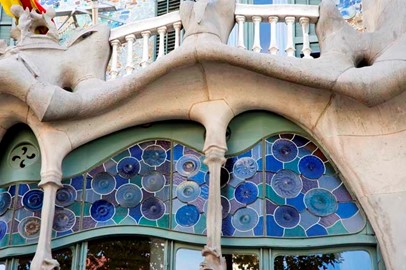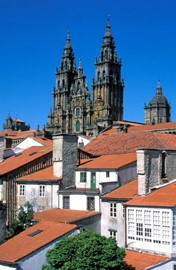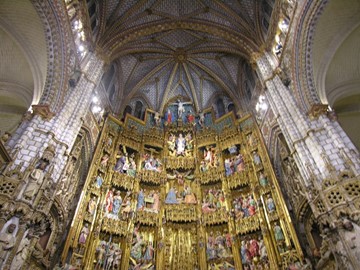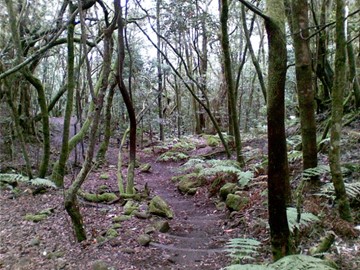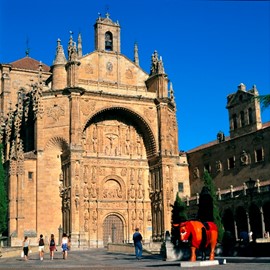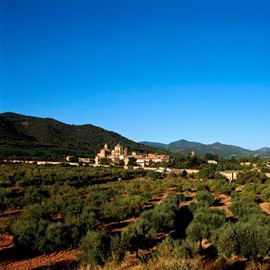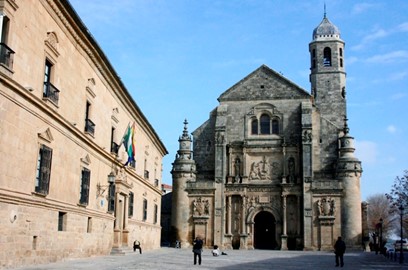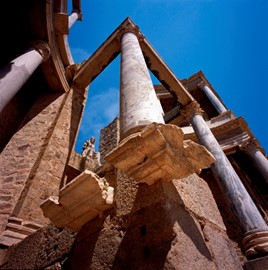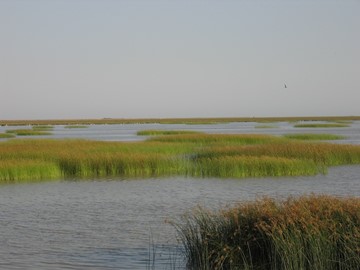region :: europe and north america
Skocjan Caves
The Škocjan Caves, a UNESCO World Heritage site in Slovenia, are a remarkable natural wonder renowned for their vast underground canyons, dramatic karst formations, and one of the world’s largest subterranean river systems. This unique cave network, shaped by the Reka River, features towering stalactites, stalagmites, and breathtaking chambers, including the colossal Martel Chamber. Recognized for its geological, ecological, and cultural significance, the site offers a glimpse into an ancient landscape that... Read More
Asturian Monuments
The Asturian Monuments, recognized as a UNESCO World Heritage site, are a collection of pre-Romanesque architectural treasures dating back to the 9th century. These structures, including churches and royal buildings, showcase a unique blend of Visigothic, Mozarabic, and early Christian influences, reflecting the cultural richness of the period. Built during the reign of the Asturian kings, they stand as remarkable examples of early medieval engineering and artistry. Their historical significance and well-pr... Read More
Cordoba
The Historic Centre of Córdoba, a UNESCO World Heritage site in Spain, is renowned for its rich blend of Roman, Islamic, and Christian influences. Its standout feature, the Mezquita-Catedral, began as a mosque in the 8th century and later transformed into a cathedral, showcasing stunning Moorish architecture with its iconic horseshoe arches and intricate tilework. The site also includes a well-preserved medieval urban layout with narrow streets, whitewashed houses, and charming patios, alongside remnants of... Read More
Alhambra, Generalife and Albayzín
The Alhambra, Generalife, and Albayzín form a remarkable World Heritage site in Spain, showcasing a blend of Islamic architecture and historical significance. The Alhambra, a stunning palace-fortress, features intricate tilework, horseshoe arches, and lush courtyards, reflecting its Moorish origins. Adjacent to it, the Generalife offers serene gardens and elegant summer residences, while the Albayzín, a well-preserved medieval neighborhood, boasts narrow streets, whitewashed houses, and panoramic views, tog... Read More
El Escurial
The Monastery and Site of the Escurial is a remarkable World Heritage site in Spain, renowned for its historical and architectural significance. Constructed in the 16th century under King Philip II, this vast complex serves as a royal palace, monastery, basilica, and mausoleum, blending Renaissance and Herrerian styles. It houses an impressive collection of art, manuscripts, and books, reflecting its role as a cultural and intellectual center. The site stands as a testament to Spain's Golden Age, offering i... Read More
Works of Antoni Gaudí
The Works of Antoni Gaudí, a UNESCO World Heritage site, showcase the visionary architect's distinctive style, blending Gothic and Art Nouveau influences with imaginative, organic forms. Iconic structures like the Sagrada Família, Park Güell, and Casa Batlló exemplify his innovative use of color, texture, and structural design, reflecting a deep connection to nature and spirituality. These masterpieces, celebrated for their artistic and architectural significance, continue to captivate visitors with their b... Read More
Santiago de Compostela
Santiago de Compostela, a UNESCO World Heritage site in Spain, is a historic city renowned for its cultural and religious significance. It serves as the culmination of the Camino de Santiago pilgrimage route, attracting visitors to its stunning Romanesque, Gothic, and Baroque architecture. The city's focal point, the Cathedral of Santiago de Compostela, is believed to house the remains of Saint James, making it a key spiritual destination. Its well-preserved medieval streets and rich history cement its stat... Read More
Toledo
Toledo, a UNESCO World Heritage site in Spain, is a historic city renowned for its rich cultural and architectural legacy. It showcases a unique blend of Christian and Jewish influences, evident in landmarks like the Gothic Cathedral of Saint Mary and the Synagogue of Santa María la Blanca. Its medieval streets, winding through a fortified hilltop, preserve centuries of history, from Roman origins to its prominence during the Visigothic and Moorish periods. Toledo remains a captivating testament to Spain’s ... Read More
Garajonay
Garajonay National Park, a UNESCO World Heritage site in Spain, is renowned for its lush laurel forests, a rare remnant of ancient subtropical ecosystems. Located on La Gomera in the Canary Islands, it boasts diverse flora and fauna, dramatic volcanic landscapes, and misty trails that attract hikers and nature enthusiasts. The park’s unique ecological significance and well-preserved natural beauty make it a global treasure.
Salamanca
The Old City of Salamanca, a UNESCO World Heritage site in Spain, is renowned for its well-preserved historic architecture and cultural significance. This ancient university city boasts stunning examples of Romanesque, Gothic, Moorish, and Baroque styles, most notably in its grand Plaza Mayor and the intricate sandstone facades of its cathedral and university buildings. As one of Europe’s oldest academic centers, it has long been a hub of intellectual and artistic achievement, attracting scholars and visito... Read More
Ibiza
Ibiza, a UNESCO World Heritage site in Spain, is renowned for its rich biodiversity and vibrant cultural heritage. The island features unique ecosystems, including Posidonia oceanica seagrass meadows, which support diverse marine life and contribute to its ecological significance. Its cultural landscape reflects a blend of Phoenician, Roman, and medieval influences, evident in historic fortifications, archaeological sites, and traditional practices that have shaped its identity over centuries. This combinat... Read More
Poblet Monastery
Poblet Monastery, a UNESCO World Heritage site in Spain, is a well-preserved Cistercian monastery founded in 1150. It served as a royal pantheon for the kings of Aragon, housing their tombs, and exemplifies medieval monastic architecture with its Gothic cloister, Romanesque church, and fortified walls. The site reflects the spiritual and political significance of the Cistercian order, offering insight into its historical influence. Today, it remains an active monastery and a key cultural landmark.
Úbeda and Baeza
Úbeda and Baeza, recognized as a UNESCO World Heritage site in Spain, are two historic towns renowned for their exceptional Renaissance architecture and urban planning. Úbeda boasts impressive monuments like the Sacra Capilla del Salvador and the Palacio de las Cadenas, reflecting the wealth and influence of its 16th-century nobility. Baeza, equally captivating, features landmarks such as the Baeza Cathedral and the Jabalquinto Palace, showcasing a blend of Gothic, Renaissance, and Plateresque styles. Toget... Read More
Mérida
The Archaeological Ensemble of Mérida, a UNESCO World Heritage site in Spain, showcases an impressive collection of Roman ruins from the ancient city of Emerita Augusta, founded in 25 BC. This well-preserved site includes a grand theater, amphitheater, temples, aqueducts, and bridges, reflecting the architectural and engineering prowess of the Roman Empire. It offers a glimpse into the daily life, culture, and governance of a provincial Roman capital, making it a significant historical and archaeological tr... Read More
Santa María de Guadalupe
The Royal Monastery of Santa María de Guadalupe, a UNESCO World Heritage site in Spain, is a historic architectural complex renowned for its cultural and religious significance. Founded in the 13th century, it blends Gothic, Mudéjar, Renaissance, and Baroque styles, reflecting centuries of artistic evolution. The monastery is celebrated for housing the revered statue of the Virgin of Guadalupe, a key symbol in Spanish history and Catholicism. Its well-preserved cloisters, church, and museum make it a remark... Read More
Doñana
Doñana National Park, a UNESCO World Heritage site in Spain, is a vital biodiversity hotspot renowned for its diverse ecosystems, including marshes, dunes, and forests. It serves as a critical habitat for numerous species, such as the Iberian lynx and migratory birds, while also supporting unique flora. The park’s ecological significance and natural beauty make it a key conservation area and a testament to Spain’s rich environmental heritage.
Cuenca
The Historic Walled Town of Cuenca, a UNESCO World Heritage site in Spain, is a remarkably well-preserved medieval fortified city perched atop a steep promontory. Its cobblestone streets, Gothic cathedral, and iconic 'hanging houses' clinging to cliff edges exemplify a harmonious blend of architecture and natural landscape, showcasing centuries of history from its Moorish origins to Christian reconquest. The town's defensive walls, once protecting it from invaders, now enclose a cultural treasure recognized... Read More
La Lonja de la Seda de Valencia
La Lonja de la Seda de Valencia, a UNESCO World Heritage site in Spain, is a masterpiece of late Gothic architecture built between 1482 and 1533. This historic silk exchange showcases intricate stonework, including twisted columns and gargoyles, reflecting its original purpose as a thriving center for trade and commerce. The main hall, with its soaring vaulted ceiling, and the adjacent pavilion highlight the wealth and artistic sophistication of the era. Today, it stands as a testament to Valencia's economi... Read More
Las Médulas
Las Médulas, a UNESCO World Heritage site in Spain, is an ancient Roman gold-mining landscape renowned for its dramatic terrain and historical significance. Formed by innovative hydraulic mining techniques, the site features rugged red cliffs, deep valleys, and a network of channels that showcase the Romans' advanced engineering skills. Abandoned after the 3rd century, it now stands as a testament to the environmental and cultural impact of Roman industry, offering visitors a glimpse into one of the largest... Read More
Yuso and Suso Monasteries
The Yuso and Suso Monasteries, recognized as a UNESCO World Heritage site, are two historic Christian monasteries renowned for their cultural and historical significance. Suso, the older of the pair, dates back to the 6th century and is celebrated as the birthplace of the written Spanish language, evidenced by early manuscripts. Yuso, established later in the 11th century and expanded over time, showcases a blend of architectural styles and houses a remarkable library of ancient texts. Together, they repres... Read More
Rock Art of the Mediterranean Basin
The Rock Art of the Mediterranean Basin, a UNESCO World Heritage site in Spain, features prehistoric paintings and engravings dating back to around 8000 BCE. Created by hunter-gatherer communities, these artworks depict human figures, animals, and hunting scenes, offering a glimpse into their daily lives and beliefs. The art, found across numerous rock shelters and caves, is remarkably preserved and showcases a variety of styles and techniques. This collection stands as a significant testament to early huma... Read More
Tárraco
The Archaeological Ensemble of Tárraco, a UNESCO World Heritage site, showcases the ancient Roman city’s monumental remains, including a well-preserved amphitheater, circus, and a provincial forum. These structures reflect Tárraco’s significance as a political and cultural hub of the Roman Empire, featuring impressive engineering and architectural designs from the 2nd century BCE onward. The site also includes a Roman aqueduct and a necropolis, offering insights into Roman urban planning and daily life. Thi... Read More
Alcalá de Henares
Alcalá de Henares, a UNESCO World Heritage site in Spain, is a historic city renowned for its rich cultural and intellectual legacy. It is the birthplace of Miguel de Cervantes, author of Don Quixote, and home to one of Europe’s oldest universities, founded in 1293 by Cardinal Cisneros. The city’s well-preserved architecture, including its Renaissance and Baroque buildings, reflects its significance as a center of learning and religion during the Spanish Golden Age. Today, it stands as a testament to Spain’... Read More
San Cristóbal de La Laguna
San Cristóbal de La Laguna, a UNESCO World Heritage site in Spain, is a historic city founded in the late 15th century, renowned for its well-preserved colonial architecture and urban layout. It served as a model for many colonial cities in the Americas, featuring a grid pattern with vibrant streets, churches, and convents. The city’s cultural significance is highlighted by its rich history as the former capital of Tenerife and its blend of European and indigenous influences. Today, it stands as a testament... Read More
Palmeral of Elche
The Palmeral of Elche, a UNESCO World Heritage site in Spain, is a remarkable historic landscape featuring an extensive grove of date palms. Established during the Islamic period between the 7th and 10th centuries, it showcases an intricate irrigation system that has sustained the palm groves for centuries, reflecting advanced agricultural practices of the time. This oasis-like setting also includes traditional huertos (garden plots) and is celebrated for its cultural and botanical significance, offering a ... Read More
